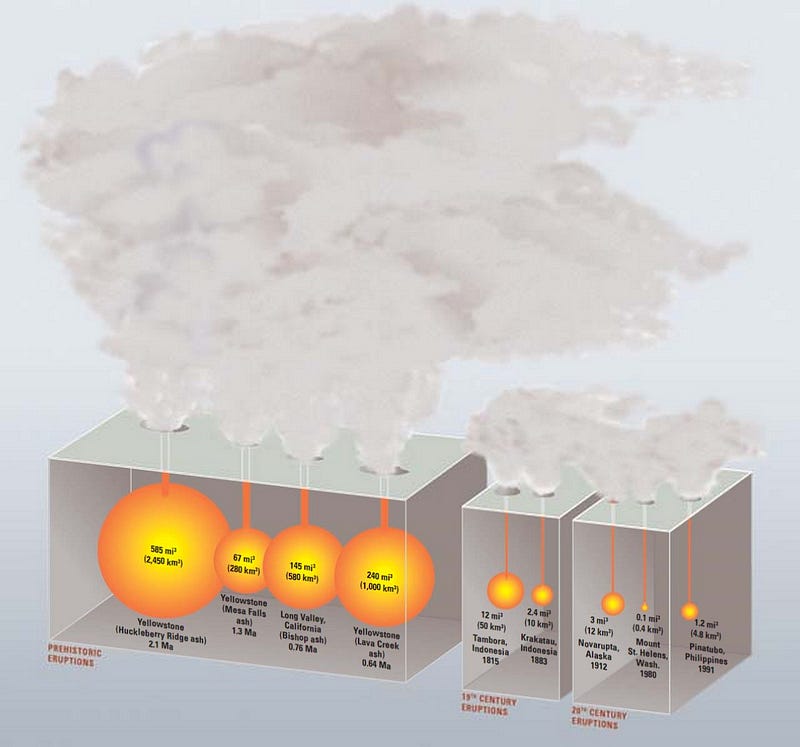Understanding Magma: The Hidden Power Beneath Our Feet
Written on
Chapter 1: The Essence of Magma
Magma, the molten rock originating from deep within the Earth, can reach extreme temperatures. When it erupts from a volcano, it creates a stunning yet perilous display. This article delves into the characteristics and significance of magma.

Before exploring what magma truly is, it's essential to understand the structure of our planet. Beneath the relatively stable surface we inhabit, known as the Earth's crust, lies a much hotter and more dynamic interior. The intense heat causes certain materials, which we recognize as solid rocks, to exist in a liquid state referred to as magma. This molten rock constitutes the Earth’s mantle, which is approximately 2,900 kilometers thick.
Temperature of Magma
The upper mantle reaches temperatures of several hundred degrees Celsius. This heat, combined with immense pressure, is sufficient to liquefy rock. Magma is composed of silicates, aluminosilicates, oxides, sulfides, as well as water and gases. Its temperature varies from 650 to 1,250 degrees Celsius. When magma reaches the Earth's surface, it can become highly destructive, threatening human structures and landscapes.
The Formation of Volcanoes
At times, magma from the mantle ascends. It often solidifies in rock fissures, creating formations known as intrusions, which serve as reservoirs for liquid magma. In most cases, this magma solidifies and does not erupt. However, there are instances when an intrusion develops into a magma chamber that retains liquid magma, allowing it to eventually surface as lava.
Video Description: This video explains the difference between magma and lava, highlighting their characteristics and significance in geology.
Mechanism of Lava Eruption
Under high pressure, magma rises and gathers in vast underground chambers, preparing for eruption. Initially, small crystals form within it, and bubbles of gas and water build up pressure until they force their way through volcanic conduits to the surface. Eruptions can occur from a central crater or through secondary vents located on the volcano’s slopes. Additionally, rift eruptions happen along a linear set of vents in the volcano. All eruption types are supplied by channels filled with magma.
The eruption's products include lava flows and pyroclastic materials, which create a cloud of steam, gases, and rock fragments. Magma that fails to reach the surface can cool and solidify underground.

Types of Magma
Magma exhibits varying densities, leading to the formation of different types of volcanoes. Dense magma, which is more acidic and rich in silicon dioxide, forms high cone volcanoes. In contrast, less dense, alkaline magma, which has a lower silicon dioxide content, results in flatter shield volcanoes.
We can categorize magma into several types based on its origin: primary magma, parent magma, derivative magma, and residual magma.
Video Description: This video focuses on the formation of magma, explaining the processes that lead to its creation and its role within the Earth's geology.
Lava Eruptions and Mass Extinctions
Over the past 500 million years, Earth has experienced five significant mass extinctions, each coinciding with extensive lava eruptions. These were not isolated incidents but rather prolonged events lasting hundreds of thousands of years. The release of vast amounts of gases and ash into the atmosphere led to drastic climatic changes. One notable event occurred 66 million years ago, contributing to the extinction of the dinosaurs. During this period, massive lava formations known as "traps" emerged in India, covering an area of 500,000 square kilometers and reaching thicknesses of up to 2 kilometers. Similar formations are also found in Siberia and the Columbia Plateau in the northwestern United States.
Magmatic Rocks
When magma solidifies deep within the Earth or lava cools on the surface, magmatic rocks are created. These are primarily classified into three categories:
- Volcanic Rocks - such as basalt and rhyolite.
- Vein Rocks - including lamprophyres and pegmatites.
- Deep Rocks - like granite and gabbro.
Magmatic rocks typically exhibit a crystalline structure, and the size of the crystals is determined by the rate at which the magma solidifies.
Conclusion
Understanding magma not only sheds light on volcanic activity but also on the geological processes that shape our planet.
If you found this article informative, feel free to leave a comment, give a clap, or even leave a tip to support my work. Follow me for more intriguing articles posted daily! Thank you for your interest!